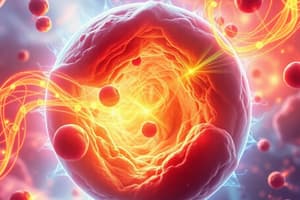Podcast
Questions and Answers
Which factor primarily determines an individual's natural body size and shape?
Which factor primarily determines an individual's natural body size and shape?
- Biology and genetics (correct)
- Physical activity level
- Dietary habits
- Social environment
What is the primary role of dietary thermogenesis in energy expenditure?
What is the primary role of dietary thermogenesis in energy expenditure?
- Conducting physical exercise
- Regulating basal metabolism
- Maintaining body temperature
- Digesting and storing nutrients (correct)
What percentage of daily energy expenditure is typically attributed to basal metabolism?
What percentage of daily energy expenditure is typically attributed to basal metabolism?
- 30-50%
- 45-70% (correct)
- 75-90%
- 10-15%
Which of the following activities is NOT considered part of physical activity energy expenditure?
Which of the following activities is NOT considered part of physical activity energy expenditure?
Which statement best describes malnutrition?
Which statement best describes malnutrition?
What is the primary kcal (calorie) definition in nutritional science?
What is the primary kcal (calorie) definition in nutritional science?
Which component of energy expenditure has the greatest variability among individuals?
Which component of energy expenditure has the greatest variability among individuals?
Approximately what percentage of calories expended in a 24-hour period is attributed to dietary thermogenesis?
Approximately what percentage of calories expended in a 24-hour period is attributed to dietary thermogenesis?
What is the formula for calculating total energy expenditure for women?
What is the formula for calculating total energy expenditure for women?
How do you convert pounds to kilograms?
How do you convert pounds to kilograms?
Which nutrient provides the most calories per gram?
Which nutrient provides the most calories per gram?
What defines a high energy density food product?
What defines a high energy density food product?
What is the first step in calculating body mass index (BMI)?
What is the first step in calculating body mass index (BMI)?
Which food has the lowest energy density?
Which food has the lowest energy density?
What is the definition of satiety?
What is the definition of satiety?
To determine your daily caloric needs including dietary thermogenesis, you should multiply your energy expenditure by which factor?
To determine your daily caloric needs including dietary thermogenesis, you should multiply your energy expenditure by which factor?
What is the recommended rate of weight loss per week?
What is the recommended rate of weight loss per week?
Which diet is recommended for promoting healthy weight loss?
Which diet is recommended for promoting healthy weight loss?
Which body mass index (BMI) qualifies an individual for bariatric surgery?
Which body mass index (BMI) qualifies an individual for bariatric surgery?
Bariatric surgery typically leads to a weight loss of what percentage of starting body weight?
Bariatric surgery typically leads to a weight loss of what percentage of starting body weight?
What is the main concern regarding prescription drugs for weight loss?
What is the main concern regarding prescription drugs for weight loss?
What should be the primary strategy for individuals facing weight issues?
What should be the primary strategy for individuals facing weight issues?
Which option matches correctly with the type of weight loss surgery according to the outcomes?
Which option matches correctly with the type of weight loss surgery according to the outcomes?
What is a characteristic of prescription medications for weight loss?
What is a characteristic of prescription medications for weight loss?
What weight category does a person with a BMI of 19.9 fall into?
What weight category does a person with a BMI of 19.9 fall into?
Which type of fat is considered more dangerous to health?
Which type of fat is considered more dangerous to health?
What waist circumference measurement is considered excess visceral fat for men?
What waist circumference measurement is considered excess visceral fat for men?
What is one limitation of skinfold thickness measurements?
What is one limitation of skinfold thickness measurements?
Which body fat assessment method is portable and easy to manage?
Which body fat assessment method is portable and easy to manage?
What is a significant limitation of underwater weighing for body fat assessment?
What is a significant limitation of underwater weighing for body fat assessment?
Which assessment method is known for providing a very high accurate assessment of fat and muscle mass?
Which assessment method is known for providing a very high accurate assessment of fat and muscle mass?
What is one of the advantages of whole body air displacement measurement?
What is one of the advantages of whole body air displacement measurement?
Flashcards are hidden until you start studying
Study Notes
Energy Balance and Weight Science
- Human body size is influenced by biology and genetics; not all can achieve desired weights or shapes through diet and exercise alone.
- Foods deliver energy (calories) and nutrients essential for growth and health.
- Individuals possess adaptive mechanisms to manage nutrient intake fluctuations.
- Malnutrition can stem from poor diets, diseases, genetic factors, or a combination.
Caloric Definitions and Energy Expenditure
- Calorie: The energy needed to raise the temperature of 1 kg of water by 1°C.
- Energy input necessary for body function; expended through three main components:
- Basal Metabolism: 45-70% of daily calorie expenditure; includes breathing, heart function, temperature regulation, and tissue renewal.
- Physical Activity: Accounts for 30-50% of energy expenditure; varies greatly among individuals. Activities include walking, tennis, dressing, and chores.
- Dietary Thermogenesis: Energy used for digesting and processing food; approximately 10% of daily caloric expenditure.
Energy Expenditure Calculation
- Women’s Total Energy Expenditure: (10 * weight in kg) + (6.25 * height in cm) - (5 * age in years) - 161
- Men’s Total Energy Expenditure: (10 * weight in kg) + (6.25 * height in cm) - (5 * age in years) + 5
- Conversion factors: 1 pound (lbs) = 0.454 kg, 1 inch = 2.54 cm.
Macronutrient Caloric Values
- Carbohydrates: 4 calories per gram
- Protein: 4 calories per gram
- Fat: 9 calories per gram
- Alcohol: 7 calories per gram
- Example calculated calories in banana bread: 30g carbs (90 cal), 7g protein (28 cal), 16g fat (144 cal) = 262 total calories.
Energy Density and Satiety
- Energy Density: Number of calories per gram; high energy density foods often contain added sugars and fewer nutrients.
- Foods with high energy density: banana bread vs. whole wheat bread; fried rice vs. steamed rice for low density.
- Satiety: The feeling of fullness or having eaten enough.
Body Mass Index (BMI)
- BMI Calculation: (weight in lbs / height in inches^2) * 703.
- BMI Classifications:
- Underweight: <18.5
- Normal weight: 18.5 - 24.9
- Overweight: 25 - 29.9
- Obese: ≥30
- Personal BMI example: 19.9 indicates normal weight.
Body Fat and Health
- Subcutaneous Fat: Located under the skin.
- Visceral Fat: Stored in the abdomen; considered more dangerous for health.
- Waist circumference: Over 40 inches for men and over 35 inches for women may indicate excess visceral fat.
Methods to Assess Body Fat
- Skinfold Measurements: Accurate if performed correctly; dependent on skilled personnel.
- Bioelectrical Impedance Analysis: Portable and relatively accurate but affected by hydration.
- Underwater Weighing: Accurate but not suitable for everyone; expensive.
- MRI: Highly accurate but costly and used primarily for research.
- DEXA Scans: Accurate assessment including bone mineral analysis; also expensive.
- Whole Body Air Displacement: Quick and suitable for diverse populations; affected by recent eating/exercise.
Diet and Lifestyle Interventions
- Effective weight loss strategies should involve:
- Diet changes
- Increased physical activity
- Behavioral/Psychological support
- Recommended weight loss: 0.5 to 2 pounds per week; personal approach should consider individual lifestyle and preferences.
Weight Loss Surgery
- Bariatric Surgery: Facilitates significant weight loss (15-30% of starting weight).
- Eligibility includes BMI >40 or ≥35 with health issues.
- Recent approvals extend to some teens with BMI >35, provided multidisciplinary support.
- Types of surgery and weight loss outcomes:
- Gastric Bypass: Most weight loss
- Adjustable Gastric Band: Least weight loss
- Gastric Sleeve: Intermediate loss
Prescription Weight Loss Medications
- Candidates: BMI ≥30 or ≥27 with chronic conditions.
- Typical weight loss: 3-12% of body weight.
- Concerns: Potential side effects and reliance on medications; lifestyle changes remain crucial.
Studying That Suits You
Use AI to generate personalized quizzes and flashcards to suit your learning preferences.




